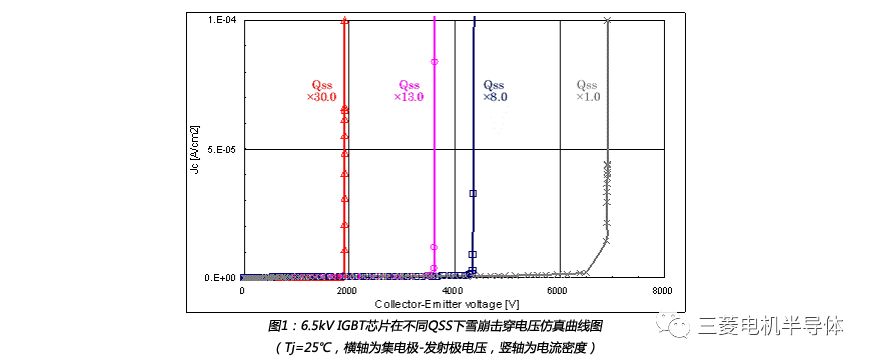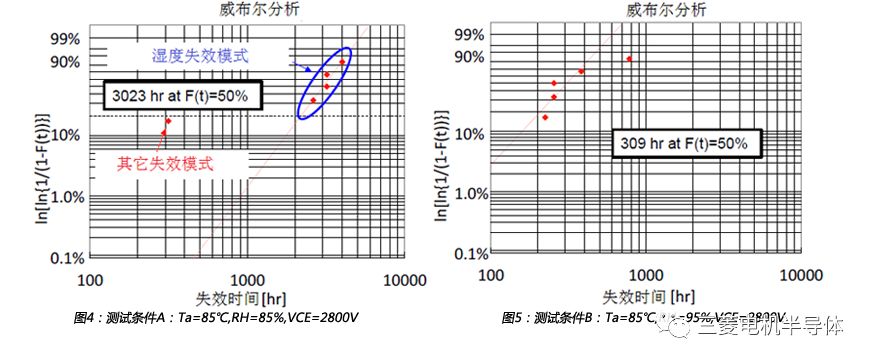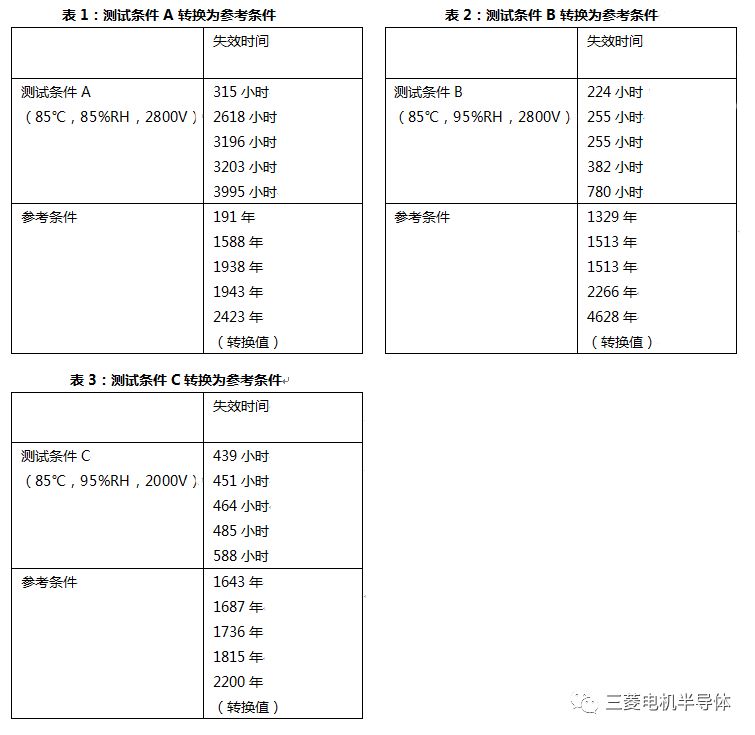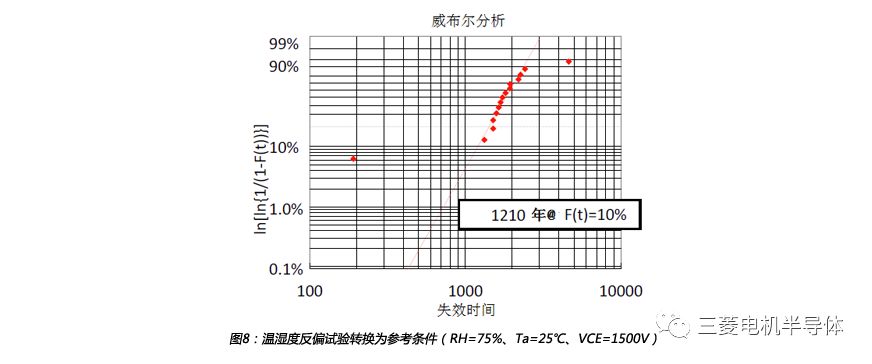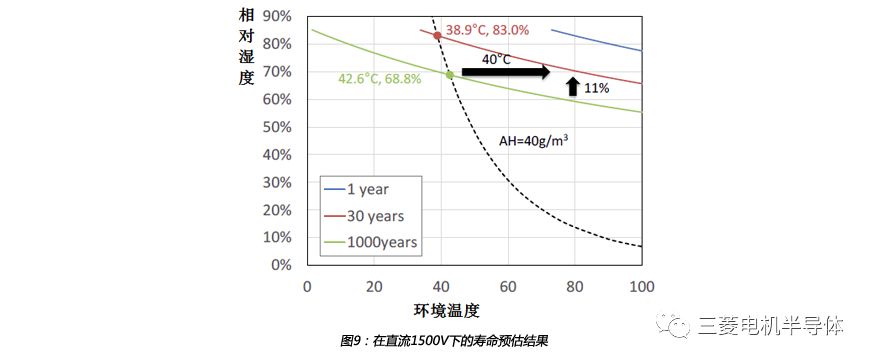Summary This paper introduces the life prediction model of high voltage IGBT modules under the influence of humidity. The humidity acceleration factor involved in this model is extracted from the temperature and humidity bias test; the high temperature IGBT temperature and humidity bias test is tested under different humidity and different voltages in order to find the humidity and voltage for the high voltage IGBT lifetime. Impact. Finally, we integrated the effects of humidity and voltage on the life of the high voltage IGBT and the temperature factor into the life prediction model. Through testing, we also found that humidity has a great impact on the life of high voltage IGBT modules. 1 Introduction In some power electronics applications, not only high-voltage IGBT modules are required to have excellent performance, but also high reliability. In order to meet actual demand, it is hoped that the life of high-voltage IGBT modules can reach 30 years. Therefore, the life expectancy of high-voltage IGBT modules is pre-predicted. Estimation is very important. Previously, although we all know that humidity has a large impact on the life of high voltage IGBT modules, there is no accurate life prediction model that takes humidity into account. Mitsubishi Electric continues to study the effect of humidity on the reliability of high-voltage IGBT modules, and thus obtains a new life prediction model for high-voltage IGBT modules. This model is used to estimate the lifetime of high-voltage IGBTs. At the same time, Mitsubishi Electric has developed a new generation of high-voltage IGBT modules using SCC (Surface Charge Control) technology, which has the ability to withstand high humidity. 2, high humidity caused by high voltage IGBT module Failure mechanism Mitsubishi Electric has studied the failure mode caused by humidity. The failure mechanism of high-voltage IGBT modules caused by high humidity is detailed in PCIM 2015 paper [2]. In general, the breakdown voltage decreases as the edge charge amount QSS of the IGBT chip increases. Figure 1 is a graph of the breakdown voltage of a 6.5kV high voltage IGBT chip as a function of QSS. The failure mechanism under high humidity conditions is as follows. When a voltage is applied between the collector and the emitter, the gel inside the high voltage IGBT is polarized, and the edge of the chip accumulates charge QSS. At the same time, the moisture in the gel accelerates the accumulation of charge. The wearing voltage will drop in a high humidity environment. Therefore, humidity and voltage will accelerate the degradation of the IGBT module, and the temperature will also accelerate the degradation of the IGBT module. Mitsubishi Electric has improved the robustness of high-voltage IGBT modules against high humidity by adopting the new IGBT chip edge technology SCC (Surface Charge Control). In order to suppress the edge charge accumulation of the IGBT chip, the SCC technology uses an optimized semi-insulating material to replace the traditional insulating material. This semi-insulating layer provides a path for the accumulated carriers, as shown in Figure 3, in high-humidity conditions. Underneath, the generated carriers are transmitted through the semi-insulating layer, avoiding a large accumulation of charges. 3. Life prediction model under the influence of humidity C. Zorn introduced an acceleration model considering humidity, temperature and voltage [1]. In the formula, αf is the acceleration factor of the test, that is, the ratio of MTTF (Mean Time To Failures) and the reference (suffix u) test conditions under the test conditions (suffix a). EA is the activation energy between 0.79 eV and 0.95 eV, and k is the Boltzmann constant. The index x is the influence of relative humidity, and the index y is the influence of voltage, which is empirical data, but must be confirmed by actual evaluation. We extend this acceleration model to the life prediction model. The humidity life model is: Humidity acceleration factor: Temperature acceleration factor: Voltage acceleration factor: Where: LTb: basic life under reference conditions; RH[%]: relative humidity of the external environment used for life calculation; T[°C]: ambient temperature for life calculation; V[V]: voltage used for life calculation; The relative humidity under the reference conditions is: RHu = 75%. The ambient temperature under the reference conditions is: Tu = 25 °C. The voltage under the reference condition is: Vu=1500V. The empirical influence factor for relative humidity is x. The empirical influence factor of the voltage is y. The activation energy EA = 0.79 eV. The Boltzmann constant k = 8.62 x 10-5 eV/K. LT is the estimated life of humidity, temperature and voltage, the parameters in the formula, LTb is the basic life under reference conditions, related to the structure of each high voltage IGBT module, humidity acceleration factor πH, temperature acceleration factor πT, voltage acceleration factor πV, other parameters come from the acceleration model. In this life estimation model, the activation energy EA is defined as a minimum of 0.79 eV. Meanwhile, with reference to the conditions, RHu=75% and Tu=25°C are the average environmental conditions in Tokyo in August. In addition, Vu=1500V is the DC network voltage. 4. Estimation of the acceleration factor 4.1 Temperature and humidity reverse bias test results The temperature and humidity reverse bias test of 3.3kV high voltage IGBT is tested under the following three conditions: test condition A (Ta=85°C, relative humidity=85%, VCE=2800V), test condition B (Ta=85°C, relative humidity) = 95%, VCE = 2800 V), test condition C (Ta = 85 ° C, relative humidity = 95%, VCE = 2000 V), and the test results are shown in Fig. 4, Fig. 5 and Fig. 6. Depending on the failure mechanism, the humidity-induced failure should be in the edge area of ​​the chip. The point of failure that occurred during the test was also at the edge of the chip, as shown in Figure 7. 4.2 Humidity acceleration factor As shown in Fig. 4, the average life of the test condition A was 3023 hours. Also, as shown in FIG. 5, the average life of the test condition B was 309 hours. Therefore, from 85% relative humidity to 95% relative humidity, the acceleration factor αf_A-B is calculated to be 3023/309=9.78. The empirical influence factor x of relative humidity is calculated by: Here RHa_testB=95%, RHa_testA=85%, so the calculation result of the above formula is x=20.5. 4.3 Voltage Acceleration Factor As shown in Fig. 5, the average life span under test condition B was 309 hours. Also, as shown in Fig. 6, the average life of the test condition C was 490 hours. Therefore, from a voltage of 2000V to a voltage of 2800V, the acceleration factor αf_C-B is calculated to be 490/309=1.59. The empirical influence factor y of the voltage is calculated by: Here Va_testB=2800V, Va_testC=2000V, so the calculation result of the above formula is y=1.37. 5. 3.3kV IGBT life expectancy 5.1 Basic life time Here, the reference conditions are defined as RHu=75%, Tu=25°C and Vu=1500V. By the formula (1), the acceleration factor αf_A in the test condition A is 5.31 k, the acceleration factor αf_B in the test condition B is 52.0 k, and the acceleration factor αf_B in the test condition C is 32.8 k. Combining these acceleration factors, the temperature and humidity reverse bias test test A, test B, and test C were converted to the reference conditions shown in Table 1, Table 2, and Table 3. The above failure points are integrated into the Weibull curve shown in Fig. 8. As can be seen from the figure, the life of F(t)=10% under reference conditions is 1210 years. At the same time, in this Weibull analysis, the maximum and minimum points are excluded. Therefore, under the reference conditions, the life of the 3.3kV IGBT is LTb=1210 years. 5.2 Life Prediction Model All parameters were confirmed by temperature and humidity reverse bias test A, test B and test C. So the new life prediction model is as follows: Humidity acceleration factor: Temperature acceleration factor: Voltage acceleration factor: LTb=1210, Tu=25°C, Vu=1500V, x=20.5, y=1.37, EA=0.79eV, k=8.62×10-5 eV/K The new life prediction model only considers humidity-induced failures, but in actual operation, failures other than humidity must be considered. 5.3 Life expectancy results Through the above life prediction model, the life of the 3.3kV IGBT under different operating conditions can be estimated. Figure 9 shows the life prediction results, including the temperature and humidity correction curves for 1 year, 30 years, and 1000 years at 1500V DC. From these curves, we can see that the 3.3kV IGBT has sufficient resistance to humidity. As can be seen from the above figure, an increase of 11% relative humidity or a temperature increase of 40 °C will result in a reduction in life from 1000 to 30 years. Therefore, the relative humidity has a greater influence than temperature. In general, the absolute humidity will remain constant as the internal temperature of the converter heats up. If the environmental conditions change from a temperature of 38.9 ° C, a relative humidity of 83.0% to a temperature of 42.6 ° C and a relative humidity of 68.8%, but the absolute humidity value is maintained at 40 g / m 3 , the life expectancy will increase from 30 years to 1000 years. Therefore, preheating is a very effective method of suppressing humidity failure. Of course, the calculated value for 1000 years is only considering the life under humidity. If other factors such as temperature cycle life are considered, the actual life of the IGBT module is not so long in practice. At the same time, the above life prediction model is based on the temperature and humidity reverse bias test, so the rapid temperature change is not considered. Especially when rapid cooling causes condensation, it is more severe than high humidity conditions. In actual operating conditions, such rapid changes in temperature should also be considered. In order to prevent condensation, preheating is also an effective means. 6 Conclusion This paper presents a life prediction model that considers the effects of humidity. Through this model, the temperature and humidity correction curves for 1 year, 30 years, and 1000 years at 1500V were obtained, and it was confirmed that the 3.3kV IGBT module has sufficient ability to suppress humidity failure. At the same time, this paper determines that high humidity will have a great impact on the life of high voltage IGBT modules, so if the converter is under high humidity conditions, the effects of humidity must be considered. Preheating is a very effective way to suppress humidity failure. 7. References [1] Christian Zorn, Nando Kaminski, “Acceleration of Temperature Humidity Bias (THB) Testing on IGBT Modules by High Bias Levels,†IEEE [2] N. Tanaka, et al., “Robust HVIGBT Modules Design against High Humidity,†PCIM Europe2015 [3] Shigeto Honda, Tatsuo Harada, Akito Nishii, Ze Chen, Kazuhiro Shimizu, “HighVoltage Device Edge Termination for Wide Temperature Range plus Humidity with Surface Charge Control (SCC) Technology,†ISPSD 2016. Interacive Display,Interactive Display Stand,2.3 Inch 16080 Lcd Display,Smart Board Interactive Display Kindwin Technology (H.K.) Limited , https://www.szktlled.com
